|
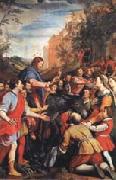 |
Santi Di Tito
|
|
Italian Painter and Architect, 1536-ca.1602
was an Italian painter of Late-Mannerist or proto-Baroque style, what is sometimes referred to as Contra-Maniera. Born in Borgo San Sepolcro, in Tuscany. There is little documentation to support the alleged training under Bronzino or Baccio Bandinelli. From 1558-1564, he worked in Rome on frescoes in Palazzo Salviati and the Sala Grande of the Belvedere (Homage of the People) alongside Giovanni de' Vecchi and Niccol?? Circignani. He acquired a classical trait, described as Raphaelesque by S.J. Freedburg. This style contrasted with the reigning ornate Roman painterliness of the Federico and Taddeo Zuccari or their Florentine equivalents: Vasari, Alessandro Allori, and Bronzino. Among his pupils was Cigoli. Another pupil named Francesco Mochi became a sculptor in the Baroque style, creating among other pieces, the colossal Saint Veronica', supervised by Gianlorenzo Bernini and placed in the crossing of St. Peter's Basilica in Rome. After returning to Florence in 1564, He joined the Accademia del Disegno, and he did not venture to paint outside of Tuscany. He contributed two unusual paintings for the Duke's study and laboratory, the Studiolo of Francesco I in the Palazzo Vecchio. This artistic project was partly overseen by Giorgio Vasari. These paintings are (the Sisters of Fetonte and Hercules and Iole). |
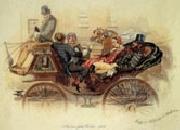 |
Samuel Thomas Gill
|
|
(Devon, England 1818 - Melbourne 1880 ) Australian/British Artist
Australian/British Artist,also known by his signature S.T.G., was and English-born Australian artist. Gill was born in Perriton, Somerset, England, son of the Reverend Samuel Gill, a Baptist minister, and his first wife, Winifred Oke. Rev. Gill became the headmaster of a school at Plymouth, where the son was first educated, then he continued to Dr Seabrook's Academy, Plymouth. Having moved to London, Gill was employed as a draughtsman and watercolour painter by the Hubard Profile Gallery, before departing for the colony of South Australia in 1839 with his parents, arriving in December. Gill arrived in Adelaide, aged 21 and established a studio in 1840, and called for those 'desirous of obtaining a correct likeness' of themselves and their families, friends, animals and residences to contact him. His activities soon expanded to include street scenes and public events, including the newly discovered copper mines at Burra Burra as well as the departure of Charles Sturt's expedition for the interior on 8 October 1844. |
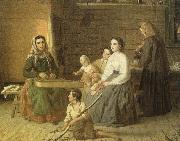 |
samuel taylor coleridge
|
|
Born: 21 October 1772
Birthplace: Devonshire, England
Died: 25 July 1834 (heart attack)
Best Known As: The author of The Rime of the Ancient Mariner |
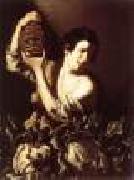 |
SALINI, Tommaso
|
|
Italian painter, Roman school (b. 1575, Roma, d. 1625, Roma).Italian painter. He has long been famed as a witness in the lawsuit of 1603 brought by his friend and biographer, Giovanni Baglione, against Caravaggio. His activity as a painter of religious works, still-lifes and genre paintings has been reconstructed in the decades following 1950, although his chronology remains uncertain. He entered the Accademia di S Luca in 1605 but was afterwards expelled on account of his 'difetto', to be readmitted in 1618. He was decorated with the Order of the Golden Spur and became a member of the Congregazione di Virtuosi al Pantheon. |
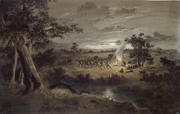 |
S.T.Gill
|
|
Australian original water-colour drawings and prints
b.1818-d.1880
also known by his signature S.T.G., was and English-born Australian artist. Gill was born in Perriton, Somerset, England, the eldest of five children. His father, the Reverend Samuel Gill, became headmaster of a school at Plymouth, and the son was educated first at this school and then at Dr Seabrook's Academy, Plymouth. Having moved to London, he was employed as a draughtsman and watercolour painter by the Hubard Profile Gallery, before departing for the colony of South Australia in 1839 with his parents. |
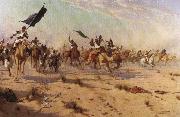 |
Robert Talbot Kelly
|
|
(1861 - 1934) was an English orientalist landscape and genre painter, author and illustrator.
Kelly was born in Birkenhead, Cheshire, the son of Irish landscape artist Robert George Kelly. He left school in 1876 to take up work in a firm of cotton traders, but was also taught art by his father, exhibiting under the name R. G. Kelly Jnr.
In the early 1880s, inspired by the places he saw while on vacation on an ocean cruise ship, Talbot-Kelly decided to take up his father's profession. He left his employment in 1882, travelled by boat to North Africa, and settled in Egypt in 1883, acquiring a studio in Cairo and becoming fluent in Arabic. He travelled throughout the country, writing about and painting the people and scenes he encountered both in towns and in the desert. He spent a considerable time with the Bedouin tribes who he described and illustrated in his 1902 book, "Egypt painted and described" (A & C Black). As his name became known he also earned an income from private commissions. He stayed in Egypt until 1915 when for reasons of health and age he returned to London - though he continued to paint constantly.
An Arab cafe in Cairo (from "Egypt painted and described", 1902)"Egypt painted and described", his first illustrated travel book, was published in 1902 (by A & C Black), and was an account of his impressions and experiences of that country during his long stay there; an exhibition of his Egyptian views was also held at the Fine Art Society in the same year. His paintings and writing showed a great empathy and respect for local people and culture, especially that of the desert Bedouin Arabs. |
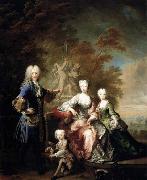 |
Robert Levrac Tournieres
|
|
Thomas William Robertson (9 January 1829 ?C 3 February 1871), usually known professionally as T. W. Robertson, was an Anglo-Irish dramatist and innovative stage director best known for a series of realistic or naturalistic plays produced in London in the 1860s that broke new ground and inspired playwrights such as W.S. Gilbert and George Bernard Shaw. |
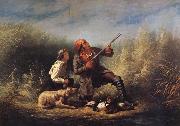 |
Ranney William Tylee
|
|
German-born American Painter, 1813-1857
American painter. He spent six formative years in the hill country of North Carolina. By 1834 he was working and studying drawing in New York, but two years later he went to Texas to join in the war for independence. Although he returned to New York a year later, it was not until 1846, with the outbreak of the Mexican War, that Ranney began to use his Western experience as the basis for his painting. With the encouragement of the American Art Union, he executed three types of Western subject: the Western trapper or hunter, pursuing a dangerous life on the prairies, as in Trapper's Last Shot (1850; untraced; engraved and lithographed by T. Dwight Booth); the pioneer family, heading across the plains with children, dogs and goods, as in Advice on the Prairie (1853; Malvern, PA, Claude J. Ranney priv. col.); and the dangers of emigration, for example Prairie Fire. |
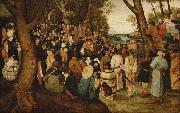 |
Pieter Brueghel the Younger
|
|
(1564 or 1565 - 10 October 1636) was a Flemish painter, known for numerous copies after his father Pieter Brueghel the Elder's paintings and nicknamed "Hell Brueghel" for his fantastic treatments of fire and grotesque imagery.
Pieter Brueghel the Younger was the oldest son of the famous sixteenth-century Netherlandish painter Pieter Brueghel the Elder (known as "Peasant Brueghel") and Mayken Coecke van Aelst. His father died in 1569, when Pieter the younger was only five years old. Then, following the death of his mother in 1578, Pieter, along with his brother Jan Brueghel the Elder ("Velvet Brueghel") and sister Marie, went to live with their grandmother Mayken Verhulst (widow of Pieter Coecke van Aelst). She was an artist in her own right, and according to Carel van Mander, possibly the first teacher of the two sons. The family moved to Antwerp sometime after 1578 and Pieter possibly entered the studio of the landscape painter Gillis van Coninxloo (1544 - 1607). In the 1584/1585 registers of Guild of Saint Luke, "Peeter Brugel" is listed as an independent master. On 5 November 1588 he married Elisabeth Goddelet, and the couple had seven children.
He painted landscapes, religious subjects and fantasy paintings. For this last category he often made use of fire and grotesque figures, leading to his nickname "Hell Brueghel".
Apart from these paintings of his own invention, Pieter Brueghel the Younger also copied the works his father had created by using a technique called pouncing. His genre paintings of peasants lack Pieter the Elder's subtlety and humanism, and emphasize the picturesque
|
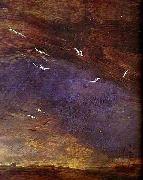 |
Pieter Bruegel the Elder
|
|
(Dutch pronunciation:c. 1525 - 9 September 1569) was a Flemish Renaissance painter and printmaker known for his landscapes and peasant scenes (Genre Painting). He is sometimes referred to as "Peasant Bruegel" to distinguish him from other members of the Brueghel dynasty, but is also the one generally meant when the context does not make clear which "Bruegel" is being referred to. From 1559 he dropped the 'h' from his name and started signing his paintings as Bruegel.
There are records that he was born in Breda, Netherlands, but it is uncertain whether the Dutch town of Breda or the Belgian town of Bree, called Breda in Latin, is meant. He was an apprentice of Pieter Coecke van Aelst, whose daughter Mayken he later married. He spent some time in France and Italy, and then went to Antwerp, where in 1551 he was accepted as a master in the painter's guild. He traveled to Italy soon after, and then returned to Antwerp before settling in Brussels permanently 10 years later. He received the nickname 'Peasant Bruegel' or 'Bruegel the Peasant' for his alleged practice of dressing up like a peasant in order to mingle at weddings and other celebrations, thereby gaining inspiration and authentic details for his genre paintings. He died in Brussels on 9 September 1569 and was buried in the Kapellekerk. He was the father of Pieter Brueghel the Younger and Jan Brueghel the Elder. Both became painters, but as they were very young children when their father died, it is believed neither received any training from him. |
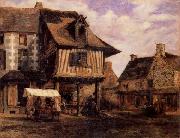 |
Pierre etienne theodore rousseau
|
|
Paris 1812-Barbizon 1867
French painter of the Barbizon school, was born in Paris, of a bourgeois family which included one or two artists.At first he received a business training, but soon displayed aptitude for painting. Although his father regretted the decision at first, he became reconciled to his son leaving business, and throughout the artist's career (for he survived his son) was a sympathizer with him in all his conflicts with the Paris Salon authorities. Theodore Rousseau shared the difficulties of the romantic painters of 1830 in securing for their pictures a place in the annual Paris exhibition. The whole influence of the classically trained artists was against them, and not until 1848 was Rousseau adequately presented to the public. He had exhibited one or two unimportant works in the Salon of 1831 and 1834, but in 1836 his great work "La descente des vaches" was rejected by the vote of the classic painters; and from then until after the revolution of 1848 he was persistently refused. He was not without champions in the press, and under the title of "le grand refus" he became known through the writings of Thor, the critic who afterwards resided in England and wrote under the name of Burger. During these years of artistic exile Rousseau produced some of his finest pictures: "The Chestnut Avenue", "The Marsh in the Landes" (now in the Louvre), "Hoar-Frost" (now in America); and in 1851, after the reorganization of the Salon in 1848, he exhibited his masterpiece, "The Edge of the Forest" (also in the Louvre), a picture similar in treatment to, but slightly varied in subject from, the composition called "A Glade in the Forest of Fontainebleau", in the Wallace Collection at Hertford House, London. Up to this period Rousseau had lived only occasionally at Barbizon, but in 1848 he took up his residence in the forest village, and spent most of his remaining days in the vicinity. He was now at the height of his artistic power, and was able to obtain fair sums for his pictures (but only about one-tenth of their value thirty years after his death), and his circle of admirers increased. He was still ignored by the authorities, for while Narcisse Virgilio Diaz was made Chevalier of the Legion of Honour in 1851, Rousseau was left undecorated at this time, but was nominated shortly afterwards. At the Exposition Universelle of 1853, where all Rousseau's rejected pictures of the previous twenty years were gathered together, his works were acknowledged to form one of the finest of the many splendid groups there exhibited. But during his lifetime Rousseau never really conquered French taste, and after an unsuccessful sale of his works by auction in 1861, |
 |
Phoebe Traquair
|
|
The leading artist the Arts and Crafts movement in Edinburgh at the turn of the century ,
(1852-1936) |
 |
Peter Tillemans
|
|
Flemish Painter, ca.1684-1734
was a Flemish painter, best known for his works on sporting and topographical subjects. Alongside John Wootton and James Seymour, he was one of the founders of the English school of sporting painting. From 1708 until his death he lived and worked in England. Tillemans was born in Antwerp in c. 1684, the son of a diamond-cutter, and studied painting there under various masters. As he was the brother-in-law of another Flemish painter, Pieter Casteels, it is assumed that he married before leaving Antwerp. Like other artists from the Low Countries such as Dirk Maas, Jan Wyck and William van de Velde, Tillemans moved to England. In Tillemans's case he moved in 1708, induced to do so by a picture-dealer called Turner: he spent the rest of his life working there. In his Sportsmen in a Landscape (1971), Aubrey Noakes offers this description of Tillemans: If we may judge from his success Tillemans was a socially agreeable and charming man. A portrait of him reveals that he was a gentle, friendly-looking fellow, with long curling hair, presumably his own and not a wig, such as was commonly worn by members of the upper and professional classes in the late eighteenth century. A chronic sufferer of asthma, Tillemans retired to Richmond "on account of his ill state of health". He died at the house of Dr Cox Macro (1683?C1767, later chaplain to George II) in Little Haugh Hall, in Suffolk, on 5 December 1734 (the previous day he "had been busy on a horse portrait") and was buried on 7 December at Stowlangtoft. His collection of paintings had been sold in an auction conducted by Dr Macro on 19 and 20 April 1733 and included paintings by James Tillemans, probably a son or other relation, |
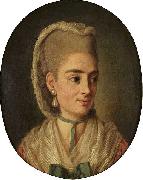 |
Per Krafft the Elder
|
|
(16 January 1724, Arboga - 7 November 1793, Stockholm) was a Swedish portraitist. He was the father of the artists Per Krafft the Younger and Wilhelmina Krafft.
|
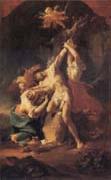 |
Paul Troger
|
|
Austrian Painter, 1698-1762
was an Austrian painter, draughtsman and printmaker of the late Baroque period. Troger's illusionistic ceiling paintings in fresco are notable for their dramatic vitality of movement and their palette of light colors. Paul Troger??s style, particularly in his frescoes, dominated Austrian painting until the end of the 18th century and profoundly influenced significant artists of the next generation, notably Franz Anton Maulbertsch, Josef Ignaz Mildorfer, Johann Wenzel Bergl. Paul Troger was born on October 30, 1698, in Welsberg, in the Puster Valley of Tyrol (now Bolzano-Bozen, Italy). At the age of 16, under the patronage of the aristocratic Tyrolean von Firmian family, he visited Fiume and became a pupil of Giuseppe Alberti.[2] He painted his first fresco ??Three Angels with the Cross and Putti??, in the Chiesa del Calvario, Kaltern am See/Caldaro al Lago, Bolzano, Italy (1722). In 1722, the prince-bishop of Gurk sent Paul Troger to Venice, where he discovered the works of Giovanni Battista Piazzetta, and Giovanni Battista Pittoni. Troger also studied in Rome with Sebastiano Ricci, in Naples with Francesco Solimena and in Bologna, the leading artistic centers of Italy at the time. On his return to Austria, Troger first worked in Salzburg from 1726 to 1728, where he painted the "Glory of Saint Cajetan" on the ceiling of St. Cajetan??s Church, Salzburg (1728). He afterwards established himself in Vienna, where the art of ceiling frescoes was, however, dominated by Johann Michael Rottmayr and Daniel Gran. Paul Troger became the favourite fresco painter in Lower Austrian monasteries in collaboration with the architect Josef Munggenast. In 1753, he joined the Imperial Academy of Fine Arts. |
 |
Octave Tassaert
|
|
Paris 1800-1874
was a French painter of portraits and genre, religious, historical and allegorical paintings, as well as a lithographer and engraver, though this family was of Flemish origin. He was the grandson of the sculptor Jean-Pierre-Antoine Tassaert. Octave's first artistic training came from his father Jean-Joseph-François Tassaert (1765-c. 1835) and his older brother Paul (?-1855), before he was apprenticed to the engraver Alexis-François Girard (1787-1870). Next he studied at the École des Beaux-Arts (1817-25) from 1817 through 1825, under Guillaume Guillon-Lethi??re, but never won the school's Prix de Rome. Winning popular but not critical success, his works showing poor people's lives were felt melodramatic by critics but acclaimed by the public. His submission to the 1855 World Exhibition was well received by the critics, but Octave ceased to exhibit after the 1857 Salon, withdrawing more and more from the formal art world. Collectors of his works included Alfred Bruyas and Alexandre Dumas, fils, but in 1863 Octave stopped painting altogether and tried to become a poet (though none of his works are extant), |
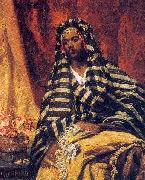 |
Noble, Thomas Satterwhite
|
|
American, 1835-1907
was born in Lexington, Kentucky. He grew up on a plantation where hemp and cotton were grown. Noble saw the effects of slavery firsthand and portrayed many scenes of the Old South in his works. He attended Transylvania University in Lexington and studied art with Oliver Frazier and George P. A. Healey and moved to New York, New York in 1853 at age eighteen. He first studied painting with Samuel Woodson Price in Louisville, Kentucky in 1852, then with Thomas Couture in Paris, 1856-1859 and returned to the United States in 1859. He served in the Confederate army from 1862-1865 during the American Civil War, despite his avowed hatred for slavery. After the war, he had a studio in New York City 1866-1869. In 1869, Noble was invited to become the first head of the McMicken School of Design in Cincinnati, Ohio, a post he would hold until 1904. During his tenure at the McMicken School of Design, Noble moved briefly to Munich, Germany where he studied from 1881-1883. He retired in 1904 and died in New York City, April 27, 1907. He is buried in Spring Grove Cemetery in Cincinnati. Noble's works are largely historical presentations. Modern critics have viewed them as overly romanticized, while others believe that he painted realistic scenes from actual events. One of his most famous paintings is The Modern Medea (1867) which portrays a tragic event from 1856 in which Margaret Garner, a fugitive slave mother, has murdered one of her children, rather than see it returned to slavery. |
 |
Nicolas Tournier
|
|
(baptised 12 July 1590 - d. before February 1639) was a French Baroque painter.
Born in Montbeliard, he followed the profession of his father, Andre Tournier, "a Protestant painter from Besançon". Little is known of his life before his arrival in Rome, where he worked between 1619 and 1626, and where he was influenced by the work of Caravaggio. According to one early source, he was a pupil of Valentin de Boulogne.Tournier's Roman paintings are stylistically close to the works of Bartolomeo Manfredi. He painted both secular and religious subjects; an example of the latter is The Crucifixion with St. Vincent de Paul (Paris, The Louvre). After 1626 Tournier was active in southern France. He died in Toulouse.
His work The Carrying of the Cross, painted around 1632, originally hung in the Toulouse chapel of the Company of the Black Penitents. During the French Revolution it was confiscated by the state and moved to a museum, from where it was stolen in 1818. After being lost for nearly two centuries, it reappeared in 2009 during an art collector's estate sale in Florence; when the Weiss Gallery of London purchased it in a Paris auction in 2011, the French government classified it as stolen property and banned it from leaving the country. |
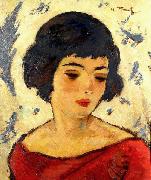 |
Nicolae Tonitza
|
|
(Romanian pronunciation: [nikoˈla.e toˈnit͡sa]; April 13, 1886 - February 27, 1940) was a Romanian painter, engraver, lithographer, journalist and art critic. Drawing inspiration from Post-impressionism and Expressionism, he had a major role in introducing modernist guidelines to local art.
Born in Bârlad, he left his home town in 1902 in order to attend the Iaşi National School of Fine Arts, where he had among his teachers Gheorghe Popovici and Emanoil Bardasare.The following year he visited Italy together with University of Bucharest students of archeology under the direction of Grigore Tocilescu.During that period, together with some of his fellow students, Tonitza painted the walls of Grozeşti church.
In 1908 he left for Munich, where he attended the Royal Academy of Fine Arts; he began publishing political cartoons in Furnica, and contributing art criticism articles to Arta Română. Tonitza spent the following three years in Paris, where he visited artists' studios, and studied famous paintings.Although the young artist's creation would initially conform to the prevalent style, his gift for colour and his personal touch would eventually lead him towards experiment.Throughout his life, he remained committed to the Munich School, hailing its innovative style over the supposedly "obscure imitators of Matisse".
|
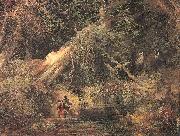 |
Moran, Thomas
|
|
American Hudson River School Painter, 1837-1926
American painter and printmaker of English birth. His brothers Edward (1829-1901), John ( 1831-1902) and Peter (1841-1914) were also active as artists. His family emigrated from England and in 1844 settled in Philadelphia where Moran began his career as an illustrator. He was guided by his brother Edward, an associate of the marine painter James Hamilton, whose successful career afforded an example for Moran. Between the ages of 16 and 19 Moran was apprenticed to the Philadelphia wood-engraving firm Scattergood & Telfer; he then began to paint more seriously in watercolour and expanded his work as an illustrator. In the 1860s he produced lithographs of the landscapes around the Great Lakes. While in London in 1862 (the first of many trips to England), he was introduced to the work of J. M. W. Turner, which remained a vital influence on him throughout his career. Moran owned a set of the Liber studiorum and was particularly impressed by Turner's colour and sublime conception of landscape. With his wife, Mary Nimmo Moran (1842-99), an etcher and landscape painter, he participated in the Etching Revival, scraping fresh and romantic landscapes and reproductive etchings |
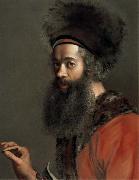 |
Maurice quentin de la tour
|
|
1704-88
French pastellist. He was one of the greatest pastellists of the 18th century, an equal of Jean-Sim?on Chardin and Jean-Baptiste Perronneau. Unlike them, however, he painted no works in oils. Reacting against the stately portraits of preceding generations and against the mythological portraits of many of his contemporaries, La Tour returned to a more realistic and sober style of work. The fundamental quality of his art lies in his ability to suggest the temperament and psychology of his subjects by means of their facial expression, and thereby to translate their fugitive emotions on to paper: 'I penetrate into the depths of my subjects without their knowing it, and capture them whole', as he himself put it. His considerable success led to commissions from the royal family, the court, the rich bourgeoisie and from literary, artistic and theatrical circles. |
 |
Mattheus Terwesten
|
|
Mattheus Terwesten (1670-1757) was a Dutch painter of portraits, architectural, and historical themes. He was court painter to Frederick William I of Prussia and professor of the art academy in Berlin.
Mattheus Terwesten studied with his brother Augustinus Terwesten, Willem Doudyns, and Daniel Mijtens the Younger. In 1695 he traveled via Berlin to Rome, where he stayed until 1699. In Rome he became a member of the painters' circle known as the Bentvueghels, where he earned the nickname "Arend", or eagle. In 1710 he joined his older brother Augustinus and younger brother Ezaias, and when Augustinus died in 1711, he succeeded him as court painter in Berlin, while Ezaias went to Italy, where he married and settled permanently.
His pupils were Herman Diederik Cuipers, Pieter van Cuyck (I), Jan van Gool, Johan Graham, Hendrik van Hulst, Jacob van Nachenius, Andries Storck, and his two sons Augustinus (II) and Pieter Terwesten. |
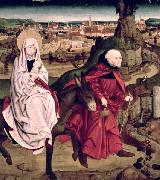 |
Master of the Schotten Altarpiece
|
|
was a German painter, active in Nuremberg during the 14th and 15th centuries. His name is derived from an altarpiece dated to about 1390, which once stood in the church of St. Mary in Schotten. The altarpiece was dismantled in 1828.
|
|

